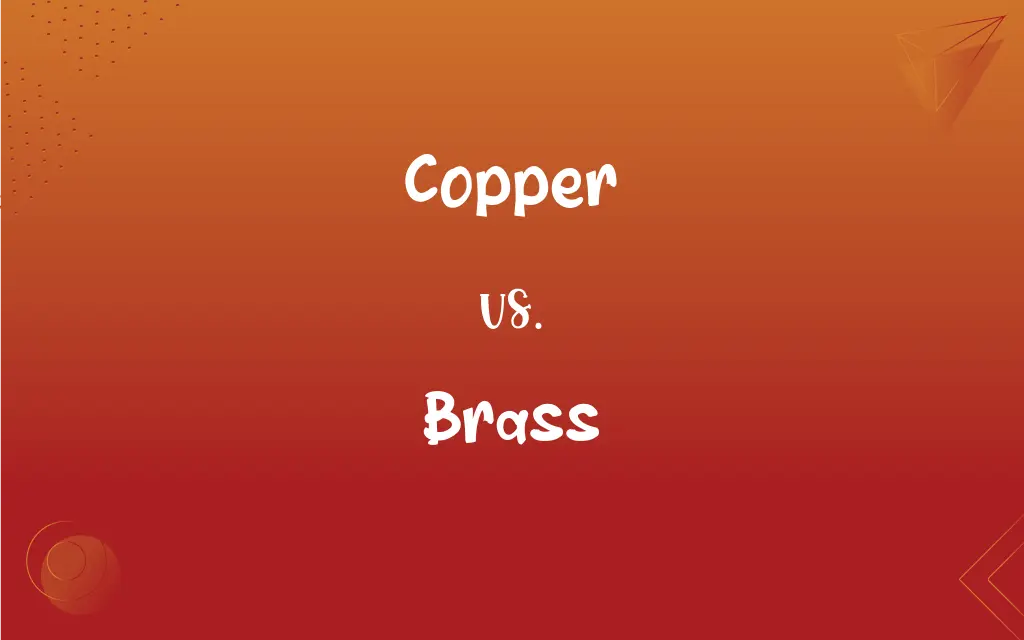Copper vs. Brass: What's the Difference?
Edited by Janet White || By Harlon Moss || Updated on October 22, 2023
Copper is a pure elemental metal with reddish-brown color, while brass is an alloy made primarily of copper and zinc.

Key Differences
Copper is a naturally occurring metal that has been utilized by humanity for thousands of years. Recognized for its reddish-brown color, copper is a good conductor of electricity and heat. On the other hand, brass, with its distinctive yellow hue, is not a pure element but an alloy composed primarily of copper and zinc.
Copper is versatile and can be found in electrical wires, plumbing pipes, and even in the human body as a vital mineral. It has antimicrobial properties, which make it useful in various medical and environmental applications. Brass, because of the addition of zinc, tends to have different properties than pure copper. This combination grants brass its unique characteristics, making it harder and more resistant to corrosion than copper.
The uses of both copper and brass are varied. While copper often finds applications in electrical circuits due to its conductivity, brass is more commonly used in decorative fixtures, musical instruments like trumpets, and in cartridge casings. The presence of zinc in brass makes it less electrically conductive compared to copper.
Another notable distinction between copper and brass is their malleability. Copper, being softer, can be bent and shaped with relative ease. Brass, although still malleable, is harder and might require more force to shape. Both materials, however, are ductile, allowing them to be drawn into wires.
The color difference between copper and brass can often be the most immediate and noticeable distinction for many. While copper boasts a reddish-brown shade, brass presents a more yellowish hue, due to the presence of zinc. Over time, both materials may tarnish or develop a patina, changing their original appearance.
ADVERTISEMENT
Comparison Chart
Composition
Pure metal
Alloy (primarily copper and zinc)
Color
Reddish-brown
Yellowish
Hardness
Softer
Harder due to zinc
Conductivity
Highly conductive
Less conductive than copper
Primary Use
Electrical wiring, pipes
Decorative items, musical instruments
ADVERTISEMENT
Copper and Brass Definitions
Copper
A reddish-brown metal that is highly conductive.
The copper wire is used in most electrical installations.
Brass
A yellowish metal used in various decorative items.
The brass doorknob added a vintage touch to the door.
Copper
A chemical element with the symbol Cu.
Copper is essential for various physiological processes in the human body.
Brass
A metal known for its resistance to corrosion.
The marine instruments were made of brass to withstand salty conditions.
Copper
A metal known for its antimicrobial properties.
Hospitals sometimes use copper surfaces to prevent the spread of microbes.
Brass
An alloy often used in musical instruments.
The brass section of the orchestra was truly impressive.
Copper
A ductile metal used for various applications.
The artisan shaped the copper into a beautiful vase.
Brass
A term sometimes used to refer to high-ranking military officers.
The decision was made by the top brass of the military.
Copper
A common material used in coins and plumbing.
The pipes in older homes are often made of copper.
Brass
An alloy made primarily of copper and zinc.
The trumpet, made of brass, gleamed under the stage lights.
Copper
Symbol Cu A ductile, malleable, reddish-brown metallic element that is an excellent conductor of heat and electricity and is widely used for electrical wiring, water piping, and corrosion-resistant parts, either pure or in alloys such as brass and bronze. Atomic number 29; atomic weight 63.546; melting point 1,085°C; boiling point 2,562°C; specific gravity 8.96; valence 1, 2. See Periodic Table.
Brass
A yellowish alloy of copper and zinc, sometimes including small amounts of other metals, but usually 67 percent copper and 33 percent zinc.
FAQs
What are the primary components of brass?
Brass is primarily composed of copper and zinc.
Which is more malleable, copper or brass?
Copper is generally more malleable than brass.
Is copper a pure metal or an alloy?
Copper is a pure metal.
Are both copper and brass used in electrical wiring?
While copper is commonly used in electrical wiring, brass is less conductive and is not the primary choice for such applications.
Which is more corrosion-resistant, copper or brass?
Brass, due to the addition of zinc, is generally more corrosion-resistant than copper.
Do copper and brass tarnish over time?
Yes, both copper and brass can tarnish or develop a patina over time.
What can cause copper to turn green over time?
Exposure to elements, particularly moisture and oxygen, can cause copper to oxidize and develop a green patina.
Which is heavier, copper or brass?
The density can vary, but generally, copper is slightly denser than brass.
Why does brass have a yellowish color?
Brass's yellowish color comes from the presence of zinc.
What is the symbol for copper on the periodic table?
The symbol for copper on the periodic table is Cu.
Is copper magnetic?
No, copper is not magnetic.
Can brass be used in jewelry?
Yes, brass is often used in jewelry due to its gold-like appearance and malleability.
How can you differentiate between copper and brass at a glance?
Copper has a reddish-brown color, while brass has a yellowish hue.
Is brass a good conductor of electricity?
Brass conducts electricity, but not as efficiently as copper.
Is copper expensive?
The price of copper can vary based on market conditions, but it is generally considered a valuable metal.
Why is brass sometimes preferred for fixtures and fittings?
Brass is often preferred due to its decorative appearance, corrosion resistance, and ease of machining.
Why is brass commonly used in musical instruments?
Brass is used in musical instruments due to its acoustical properties and resistance to corrosion.
Are there different types of brass?
Yes, there are various types of brass, differing in the ratios of copper to zinc and sometimes other elements.
What other elements can be added to brass?
Besides copper and zinc, brass can contain elements like lead, tin, and iron, depending on the desired properties.
Are there health benefits associated with copper?
Yes, copper is an essential mineral for the human body and plays a role in various physiological processes.
About Author
Written by
Harlon MossHarlon is a seasoned quality moderator and accomplished content writer for Difference Wiki. An alumnus of the prestigious University of California, he earned his degree in Computer Science. Leveraging his academic background, Harlon brings a meticulous and informed perspective to his work, ensuring content accuracy and excellence.
Edited by
Janet WhiteJanet White has been an esteemed writer and blogger for Difference Wiki. Holding a Master's degree in Science and Medical Journalism from the prestigious Boston University, she has consistently demonstrated her expertise and passion for her field. When she's not immersed in her work, Janet relishes her time exercising, delving into a good book, and cherishing moments with friends and family.































































